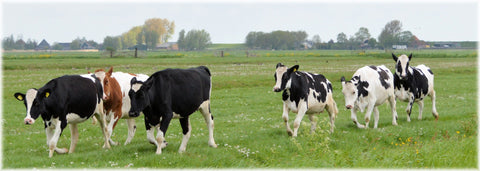Why Grass Fed Tallow?
Legend has it, that the first soap was created on Mount Sapo ("sapo" is Latin for "soap") when the animal fats and ashes from burning sacrifices would trickle down the hill and run into the nearby stream where the village women, who were washing laundry, would see the bubbles made. For thousands of year, soaps and salves were made from grass fed tallow. Tallow even made the precious commodities of soaps and candles for our homesteading forefathers. At the time, all tallow was grass fed because GMO feed, antibiotics, and synthetic hormones simply didn't exist. It wasn't until the beginning of the 20th century that tallow was becoming replaced with hydrogenated vegetable oils due to the rising vegetarian movement, and tallow lost meaning in our vocabulary.

Unfortunately, due to compounding factors in diet, skincare, and hectic lifestyles, we have seen a rise in health issues including degenerative skin conditions, skin cancers, and dry skin in general. However, while we find that synthetic detergents and artificial fragrance harm the skin, vegetable soaps don't necessarily benefit the skin, either. Vegetable soaps don't have the same skin repairing and moisturizing benefits that our tallow-based soaps do. Looking back to how our forefathers lived, we can clearly see that the healing benefit of tallow come from that which is grass fed.

So, now let's talk about why tallow works so well. Since tallow comes from an animal, it contains the same ratio of saturated fats to monosaturated fats as humans. (1) This makes the tallow absorb quickly into our skin as nourishment without feeling greasy, heavy, or gooey. It has a natural feel because it's just like our oils on a molecular level, and it's non-comedogenic (doesn't clog pores). However, the source of our tallow is very important. Tallow from modern day cattle will be lacking in many essential nutrients as well as contain many man-made toxins which are found in non-organically raised animals such as pesticides, antibiotics, artificial hormones, and their metabolic by-products. It is not carefully selected, but rather, it comes from the offal from slaughterhouses, which then undergoes pulverization, steam-heating, refining, bleaching, and deodorizing, with the final addition of chemical preservatives such as BHA, BHT, and propyl gallate.(2)
By sourcing grass-fed and grass-finished tallow, we ensure that we have the highest nutritionally available tallow. Grass-fed tallow contains a better mineral and micronutrient profile, including higher levels of vitamins. For example, grass-fed tallow has 4x more vitamin E than it's grain-fed counterpart.(3) Grass-fed tallow was found to have three to five times more conjugated linoleic acid, which is anti-cancer(4) and anti-inflammatory, as well as palmitoleic acid, which has natural antimicrobial properties.(5, 6) A 2006 study on fats shows that CLA has significant anti-cancer effects, and that supplying tallow increased those effects due its palmitic acid, another fatty acid.(7)

We can see that our forefathers were on to something! Grass fed tallow is an ethically derived nourishing fat that makes a wonderful soap or balm that can be used on the face and all over the body. In soap, it adds hardness and longevity as well as being amazingly moisturizing and wholesome for our skin!
Reference:
1. Fallon, Sally, Enig, Mary G., PhD (2001). Nourishing Traditions. NewTrends Publishing, Inc., Washington: 18.
2. Welch, Holme & Clark Co., Inc. “Edible Beef Tallow”. (http://www.welch-holme-clark.com/edible_beef_tallow_spec.html)
3. Smith, G.C., “Dietary supplementation of vitamin E to cattle to improve shelf life and case life of beef for domestic and international markets”. Colorado State University, Fort Collins.
4. Ip, C, J.A. Scimeca, et al. (1994). “Conjugated linoleic acid. A powerful anti-carcinogen from animal fat sources.” Cancer 74(3 suppl):1050-4.
5. Fallon, Sally, Enig, Mary G., PhD (2001). Nourishing Traditions. NewTrends Publishing, Inc., Washington: 28.
6. Dhiman, T. R., G. R. Anand, et al. (1999). “Conjugated linoleic acid content of milk from cows fed different diets.” J Dairy Sci 82(10): 2146-56.
7. Enig, Mary G., PhD (Winter 2007). Wise Traditions in Food, Farming and the Healing Arts. “Some Recent Studies on Fats”.
